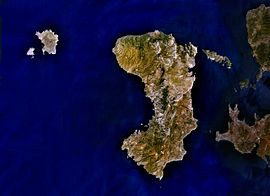Chios
Χίος | |
|---|---|
 | |
| Coordinates: 38°22′39″N 26°03′54″E / 38.37750°N 26.06500°E | |
| Country | Greece |
| Administrative region | North Aegean |
| Regional unit | Chios |
| Government | |
| • Mayor | Ioannis Malafis[1] (since 2023) |
| Area | |
• Municipality | 842.3 km2 (325.2 sq mi) |
| Highest elevation | 1,297 m (4,255 ft) |
| Lowest elevation | 0 m (0 ft) |
| Population (2021)[2] | |
• Municipality | 50,361 |
| • Density | 60/km2 (150/sq mi) |
| Time zone | UTC+2 (EET) |
| • Summer (DST) | UTC+3 (EEST) |
| Postal code | 82x xx |
| Area code(s) | 227x0 |
| Vehicle registration | ΧΙ |
| Website | www.chios.gr |
Chios (/ˈkaɪ.ɒs, ˈkaɪ.oʊs, ˈkiː-/; Greek: Χίος, romanized: Chíos [ˈçi.os] , traditionally known as Scio in English) is the fifth largest Greek island, situated in the northern Aegean Sea, and the tenth largest island in the Mediterranean Sea. The island is separated from Turkey by the Chios Strait. Chios is notable for its exports of mastic gum and its nickname is "the Mastic Island". Tourist attractions include its medieval villages and the 11th-century monastery of Nea Moni, a UNESCO World Heritage Site.
Administratively, the island forms a separate municipality within the Chios regional unit, which is part of the North Aegean region. The principal town of the island and seat of the municipality is Chios.[3] Locals refer to Chios town as Chora (Χώρα literally means land or country, but usually refers to the capital or a settlement at the highest point of a Greek island).
The island was also the site of the Chios massacre, in which tens of thousands of Greeks on the island were massacred, expelled, and enslaved by Ottoman troops during the Greek War of Independence in 1822. Chios remained a part of the Ottoman Empire until 1912.
- ^ "Municipality of Chios, Municipal elections – October 2023". Ministry of Interior.
- ^ "Αποτελέσματα Απογραφής Πληθυσμού - Κατοικιών 2021, Μόνιμος Πληθυσμός κατά οικισμό" [Results of the 2021 Population - Housing Census, Permanent population by settlement] (in Greek). Hellenic Statistical Authority. 29 March 2024.
- ^ "ΦΕΚ B 1292/2010, Kallikratis reform municipalities" (in Greek). Government Gazette.

